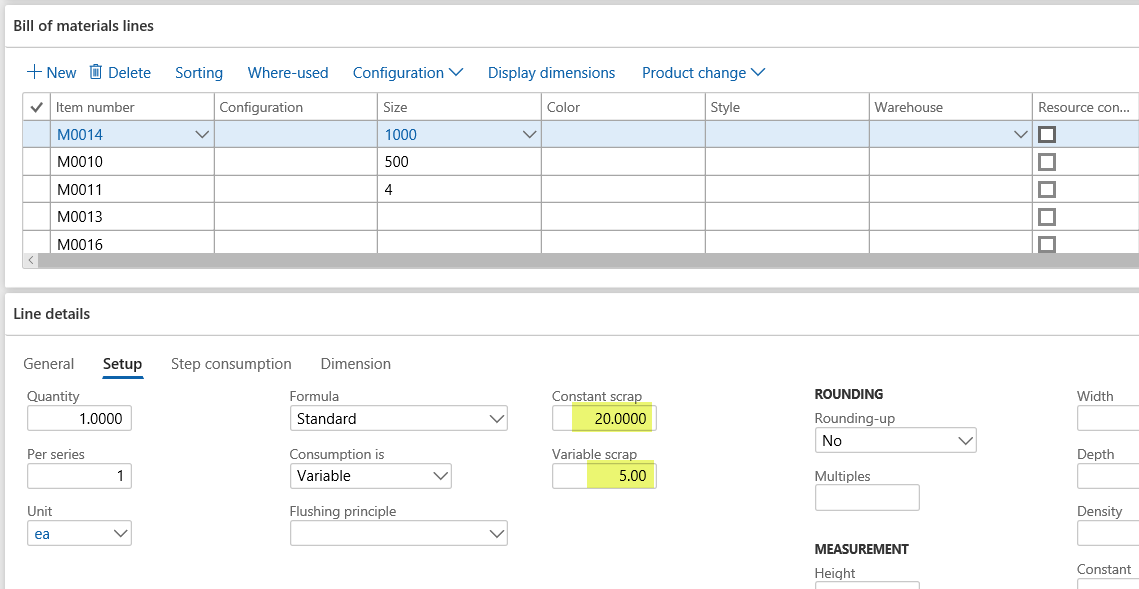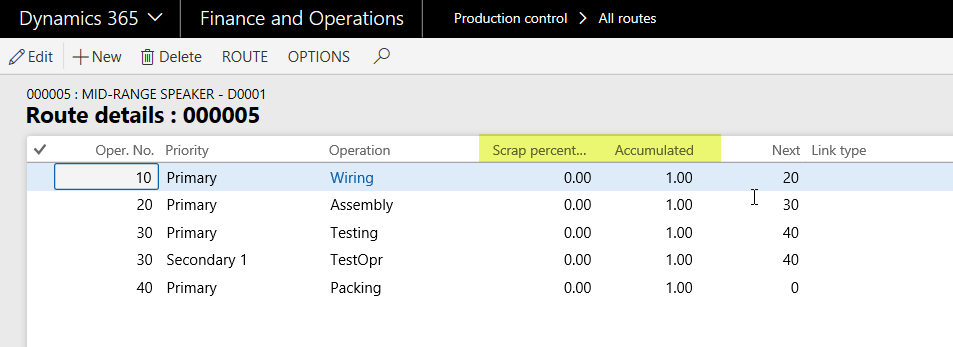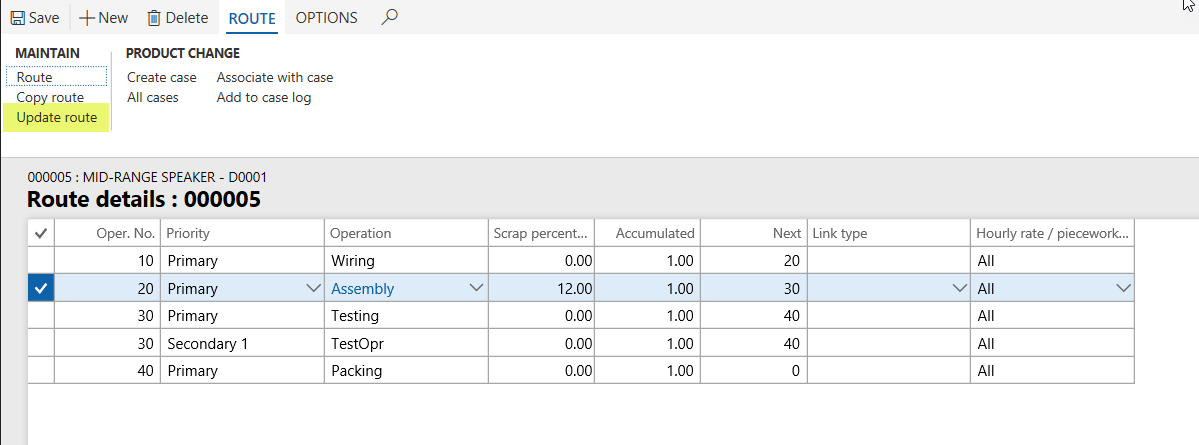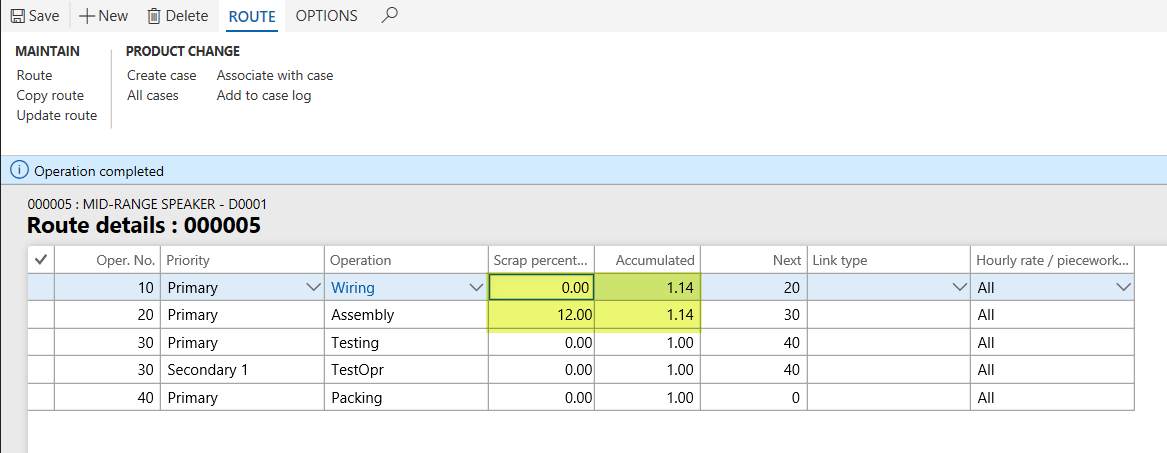One of the more complex screens in the Production Control module in Microsoft Dynamics 365 for Finance and Operations is the Route Details screen and the columns for Scrap and Accumulated Scrap. When you first see it, the screen looks underwhelming. However, not only does the screen represent an important concept, but analyzing exactly how it is computed is anything but clear.
To start with, let’s first understand what “Route” scrap means as opposed to the basic material scrap that we would indicate on the BOM or the Formula.
Product information management > Bills of materials and formulas > Bills of materials

Constant and Variable Scrap
In this BOM, in the line details, you can see the material scrap for Item M0014, is set as a Constant of 20 and a Variable of 5%. This means that regardless of the quantity needed for the order, you expect to see 20 items be “scrapped” and thus unusable. You will need to pick an extra 20 items in order to have enough of the item to produce the order. For example, you may be building bookcases and in order to adjust your power saw to the exact dimensions, it takes 20 items to find the exact settings. These added items picked will be included in the cost of the final item.
The 5% Variable scrap means that of the volume needed for the order, you will need an additional 5% of the item. (While it is unusual to have both constant and variable scrap on an item, it is definitely a possible situation.) Again, this additional 5% is an added cost as you will need to pick, in addition to the 20 items of constant scrap, another 5% of the volume needed for the order will need to be picked and eventually charged to the total cost.
This concept of scrap is a basic concept: you expect some spoilage, some items to be rendered unusable during the manufacturing process. If you don’t experience the expected quantities of scrap, you put the items back into inventory and your end cost will be reduced.
Route Scrap
Route scrap, however, is a bit more complex. In the screen shot below, you see how the route is set up:
Production control > All routes

In this example, you see no route scrap, but an “Accumulated” of 1.0 percent. This means that with no scrap during any operation, you will need 100% of the items called for in the BOM to appear on the pick lists, which will include any material scrap. The accumulated number on each line represents what percent of the items, as listed on the route details, D0001, you will need to complete that operation. Without any scrap percentage on any operation, you simply need 100% of what the BOM required which will include material scrap.

“Route scrap” is defined as scrap expected to be experienced during the process of performing those operations during the order. For example, in Operation 20, Assembly, you can see that I have adjusted the route scrap to 12%, which means that while assembling, you expect that 12% of whatever items used will end up being scrapped.

The Accumulated scrap will remain unchanged until you update the route as shown here:

After updating, note how the screen has changed:

The Accumulated scrap is now set at 1.14 for the first and second operations. So what does that mean? First of all, there is a formula used to compute this number, which is:
Accumulated% = Accumulate% (following operation) × 100/(100 – scrap percentage)
Given that the math works to compute this, it’s important to understand what it means in order to understand the concept. If, during the second operation you expect a 12% scrap, it means that in order to have enough items to produce the quantity in the order, you need to make more items in the first operation! In this case, for example, if the order was for 100 finished goods, you need to have 114% or 114 items so that in the second operation, you can scrap 12% and still have enough items for the third operation. Doing the math, 114×12% = 13.68, rounded up to 14, means you need to make the 14 more in operation 10 so that you can scrap 12% in operation 20 to have 100 items for operation 30.
This makes perfect sense if you think about it. If you expect route scrap, you need to have more on hand for that operation. If you didn’t make the extra 14 in operation 10, you would end up with 88 items after the 12% scrap in operation 20, and that wouldn’t be enough to complete the order.
Want to learn more? Interested in training for Dynamics 365 for Finance and Operations? Visit the RSM Technology Academy website at academy.rsmus.com to view our live, virtual and self-paced training options. You can also email us at academy@rsmus.com with any questions or specific training needs.
By: Howard LeCover

 RSMUS.com
RSMUS.com